Top 5 Binocular (Compound) Microscope To Buy In 2022 Reviews
Do you want to learn about binocular microscopes?
Then keep reading!
In this review, you can find out more about binocular microscopes, as well as what they are most used for, and why. They will be compared to regular (monocular) microscopes, and you can decide which ones you need.
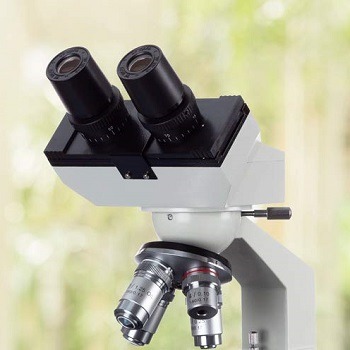
What Are Binocular Microscopes And More About Them
What Defines A Binocular Microscope?
A binocular microscope is, as the name suggests, a microscope that has 2 eyepiece lenses. In most cases, they are separate and used to view through one with each eye. However, the definition lies in the viewing field which is observed. Therefore, under certain conditions, even some microscopes that only have one eyepiece can still be considered binocular.
Different Types Of Binocular Microscopes
There is, for instance, the stereo microscope, which uses two optical paths and displays a separate image to each eye and creates a new image by overlaying. Then, there is the compound microscope, showing a 2D image through one optical path. The comparison microscope shows a different image to each eye, which enables you to compare the two.
Other Differences Between Binocular Microscopes
Some other differences among such microscopes are roughly equal to those between any type of microscopic device. Some of them are: the binocular microscope magnification range available, source of illumination used, and whether or not they enable capturing and saving images.
Where Are They Used Most And Why?
Binocular microscopes can be found in any facility where prolonged and regular use of microscopes is expected. That is because the two eyepieces enable the user to comfortably view the sample which they are observing, with less strain on their eyes and neck than a regular, monocular device would cause.
Advantages And Downsides Of Binocular Vs. Monocular
Firstly, the most notable difference is in the construction, and therefore mobility of the device. Monoculars are lighter and more portable compared to binoculars. However, the enhanced viewing field and comfort benefits of using a binocular are far greater than matters of mobility. Monoculars would be used more often only in cases of targeted short-term applications and when the cost of the device is an issue.
Best 5 Binocular Microscope Reviews For Sale
Best Binocular Dissecting Microscope
AmScope B100B-MS Compound Binocular Microscope
What Does It Have?
This device has a binocular sliding head and comes with two sets of widefield eyepieces (WF10x/18 and WF20x). It has 4 achromatic objectives and a mechanical stage with a stain-resistant finish. It offers coarse and fine focusing on separately adjustable knobs, and electrical illumination provided by a tungsten lamp (20W).
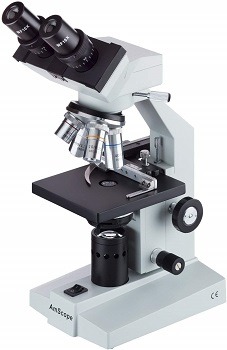
Quality Lenses
This microscope is produced according to ISO 9001 quality control standards. Also, it was made on par with some of the best optical instruments out there, like Leica, Olympus, and Nikon. It offers a magnification range of 8 settings: 40x, 80x, 100x, 200x, 400x, 800x, 1000x, and 2000x.
Additional Equipment
The main construction is made fully out of solid metal with stain-resistant enamel finish. Furthermore, AmScope comes with some additional equipment, like a dust cover, color filters, a spare bulb, a wrench for adjusting focusing tension, immersion oil, and a customer information sheet. The latter also provides you with a download link for a digital version.
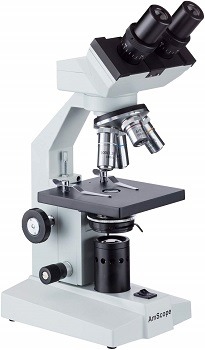
Component Details
Dimensions of the device are 18 x 12 x 8 inches, and it weighs 3.25 pounds. Fully coated optical system and Abbe condenser with iris diaphragm and filters, along with precision ground glass lenses, provide high resolution and sharp clear images.
Convenience Of Use
The 45° inclined binocular microscope head swivels in full 360°, and you can adjust the interpupillary distance as well as diopter on oculars. The mechanical stage (dimensions 4.3 x 4.7 inches) for easy gliding control, also comes equipped with an upward stage stopper, to protect both objectives and slides.
- full metal construction
- good quality optics
- additional equipment
- warranty
- front-facing nosepiece
- 1 layer stage
Best Binocular Biological Microscope
Labomed LB-240 Binocular Compound Microscope
What Makes It Special?
Considering some features and magnification power, it is very similar to the previous model mentioned, but with some specific upgrades. Namely, its precise equipment and advanced alignment technology, as well as anti-fungal coating, makes it an efficient biological microscope. It is safe to use in medical and sanitary establishments, institutes, laboratories, universities, etc.
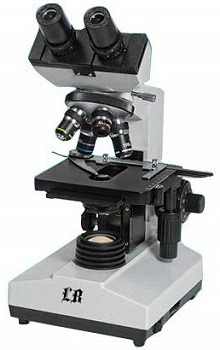
Product Design And Size
Dimensions of the entire device are 13 x 11 x 17.3 inches, whereas the stage dimensions are 5.5 x 5.5 inches. Much like the previous model, it has a forward-facing nosepiece with 4 objectives, with a magnification range from 40x to 1000x. It weighs a heavy 19.8 pounds.
Comfort And Adjustability
The interpupillary distance on the eyepieces on this binocular microscope can be adjusted between 2.2 – 3 inches. The forward-facing nosepiece eases changing objectives, but not adjusting or changing slides. The brightfield LED light comes with a rheostat, as well as Abbe condenser with a diaphragm.
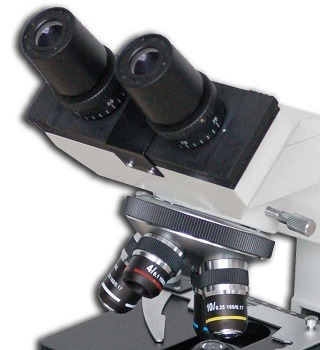
Technical Specifications
Sliding binocular head has 360° rotation capability and widefield eyepieces (WF10x18). Plan achromatic objectives ensure improved focus and color correction, and the 2-layered mechanical stage enables precise slide adjustments along the X- and Y-axis. Coaxial coarse and fine focus is conveniently nested for both sides.
Safety Features
This device has optics with anti-mold coating, which preserves them even in highly humid conditions. Objectives are made to retract upon contact, preventing potential damage. The adjustable light source ensures the preservation of sensitive specimens.
- comfortable use
- advanced stage design
- color correction
- anti-fungal coating
- adjustable illumination
- forward-facing nosepiece
- aluminum body
- heavy
- high price
Best Binocular Stereo Microscope With Camera
Leica EZ4 W Stereomicroscope With Wi-Fi Camera
Where Can It Be Used?
The Leica EZ4 stereomicroscope with an integrated Wi-Fi camera is an excellent addition to a science classroom. It can be used to research samples and share images with the rest of the class or peers. The data can also be shared through an HDMI connection, allowing you to preview what the camera sees on an HD screen or a larger projector.
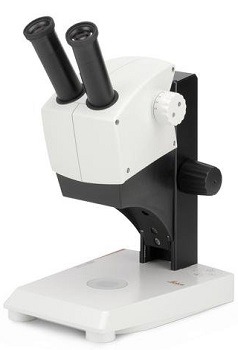
Compact Stereo Microscope Design
This device is most notably different from the first two products by its design. Sleek, compact, with no removable parts, it is mostly break-proof and safe, even for users with minimal experience with this type of device. However, the construction materials could be more durable than the ones used.
Dimensions And Features
The dimensions of this binocular microscope are 17.6 x 13.1 x 9.8 inches, and it weighs 13.35 pounds. It has a 4.4:1 zoom, which is suitable for entry-level university and college courses (such as anatomy, biology, and chemistry).
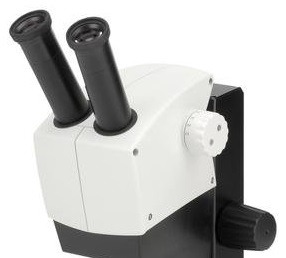
Efficient Illumination System
The LED lights integrated into this device, 7 in total, provide powerful light from 7 different parts of the device, ensuring the specimen you are observing is illuminated from every angle. The producer assures the LEDs to have about 20 years’ worth of light in them, which decreases expenses regarding replacement light bulbs.
Integrated Camera
Leica binocular microscope comes with an integrated 5 MP camera, which can be used to live-stream HD pictures to a computer, projector, or even students’ laptops or even tablets and smartphones. Students can use the internal or facility’s own Wi-Fi signal to connect to the microscope, using devices with Windows, Mac, Android or iOS.
- Wi-Fi camera
- software app available
- compact design
- appearance
- minimal adjustability
- cost for quality
Best Binocular Compound Microscope
Omax 40x-2000x Lab LED Binocular Microscope (M82ES)
Application And Practicality
Omax binocular biological microscope is suitable for school, research, examination, in laboratories and other facilities. It can connect to a digital USB camera that you can buy separately, to use with this product.
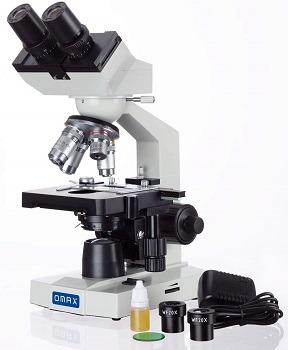
Superior Magnification
This device offers 8 magnification settings, and they range from 40x-2000x. Knobs for adjusting coarse and fine focus exist on both sides of the device. Widefield eyepieces come in wf10x and wf20x, with an adjustable ocular diopter on both.
Advanced Stage Build
The double-layer mechanical stage enables full movement, as the entire stage moves in three dimensions (X-, Y- and Z- axis). Stage dimensions are 4.5 x 4.9 inches, and it has an upwards lock to protect slides and objectives from damage when closing in.
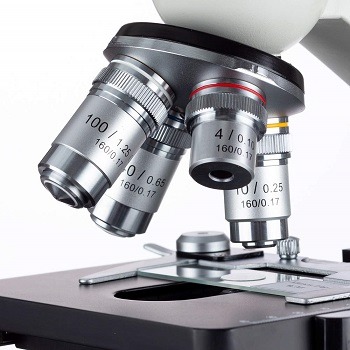
Nosepiece And Illumination Information
The nosepiece is a classical revolving quadruple turret with achromatic DIN objectives in 4x, 10x, 40x and 100x. It is forward-faced, which means it is more practical to exchange objectives on it than it is to switch slides under it.
Frame And Design
The Omax binocular microscope has a solid full metal frame construction, with stain-resistant enamel finish. The viewing binocular head is inclined by 45° and swivels by 360°. This device is illuminated by LED light with adjustable intensity, and comes with an NA1.25 Abbe condenser and iris diaphragm.
- top stage design
- good magnifying range
- solid metal
- warranty
- forward-facing nosepiece
- product dimensions unknown
- basic design style
Best Binocular Stereo Microscope
Nikon 20x Field Stereoscopic Microscope Mini
Light And Portable
With its dimensions being 3.5 x 3.5 x 4.9 inches, and weighing only 0.87 pounds, this portable binocular microscope is ideal for field use. The O-ring seal protects against moisture and dust, and contributes to its safe and practical use on the go.
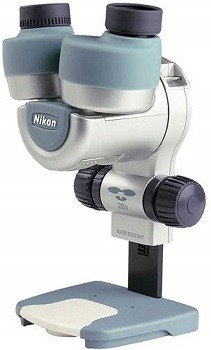
3D Viewing And Depth
Nikon binocular microscope has a 0.4-inch clear viewing field, with a good sense of depth and 3-dimensional viewing. The magnification, however, is fixed at 20x, which unfortunately makes for the device’s limited application.
Foldable Viewing Head
This small device has a sturdy viewing head that rotates inwards and places the eyepieces facing downwards toward the stand. This option increases security and practicality during storage and transport.
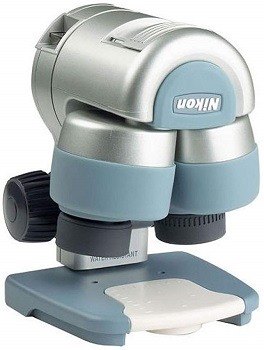
Adjustable Eyepieces
The eyepieces have an adjustable interpupillary range from 2 – 2.8 inches, with up to +/- 3 optic correction. The microscope does not have a built-in light source, which means it uses the natural light from its surroundings to create a 3D erect unreversed image.
Design And Use
Nikon mini binocular microscope has a detachable plate with a flat front and curved rear, which enables easy observing of liquid specimens. The focus knob torque can be adjusted, and the focus range is 1.7 inches. Also, this device has a standard tripod socket, for versatility and stability during use.
- small and compact
- lightweight
- water resistant
- tripod socket
- low magnification
- fixed magnification setting
- no proper stage
- plastic
- no additional illumination
Conclusion: Which Binocular (Compound) Microscopes To Buy?
In my view, the top 2 binocular microscopes are the Labomed LB-240 compound microscope, and the Omax LED Lab binocular microscope. The Omax binocular microscope impresses with its magnification range and stage design. Labomed LB-240 is great for medical and biological research and dissection, thanks to its advanced features. The Labomed one also has anti-fungal coating and color correction technology.
If you are interested in the binocular microscopes, read this post on the best microscopes. For more information on other microscope types, check out compound microscopes and best digital microscopes.
